- Article
- Source : Campus Sanofi
- 9 déc. 2025
Inflammation de type 2 et polypose naso-sinusienne (PNS) : identifier et prendre en charge les patients

Identifier l’inflammation de type 2
Dans les pays occidentaux, l’inflammation de type 2 est présente chez 80% des patients atteints de polypose naso-sinusienne1. L’inflammation de type 2 chez les patients atteints d’une polypose naso-sinusienne se caractérise par différents signes à rechercher2,3 :
- Besoin de corticostéroïdes systémiques
- Récidives post-chirurgies
- Taux d’EOS élevé et/ou taux d’IgE totales élevé
- Antécédents d’asthme et/ou autres comorbidités de type 2 (rhinite allergique, maladie respiratoire associée à une intolérance à l’aspirine/AINS, etc)
50% des patients avec une polypose naso-sinusienne ont aussi un asthme4.
Cas clinique
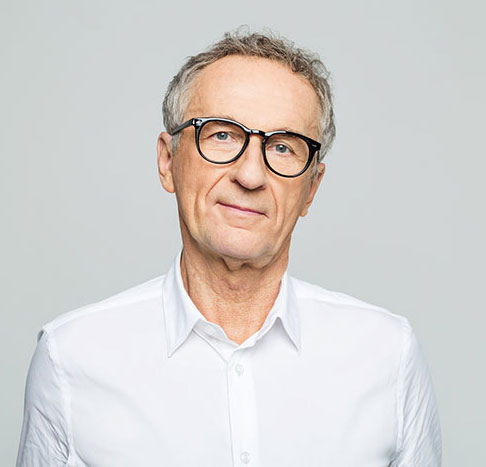
Charles, 59 ans, est atteint de polypose naso-sinusienne. Charles présente les symptômes suivants : perte de l'odorat, congestion/obstruction nasale, douleur faciale et fatigue.
« Ma polypose me gêne au quotidien. J’ai déjà subi une chirurgie et mon odorat n’est pas revenu… »
Dans ce cas, l’inflammation de type 2 est à considérer comme facteur de la polypose naso-sinusienne5,6.
Le profil patient est indicatif et n’est pas un patient réel.
AINS : anti-inflammatoire non stéroïdien ; EOS : éosinophile ; IgE : immunoglobuline E.
Cibler les cytokines majeures de l'inflammation de type 2
IL-4, IL-13 et IL-5 sont des acteurs clés dans la cascade inflammatoire de type 2 et participent au remodelage des tissus et à la formation des polypes5-8.
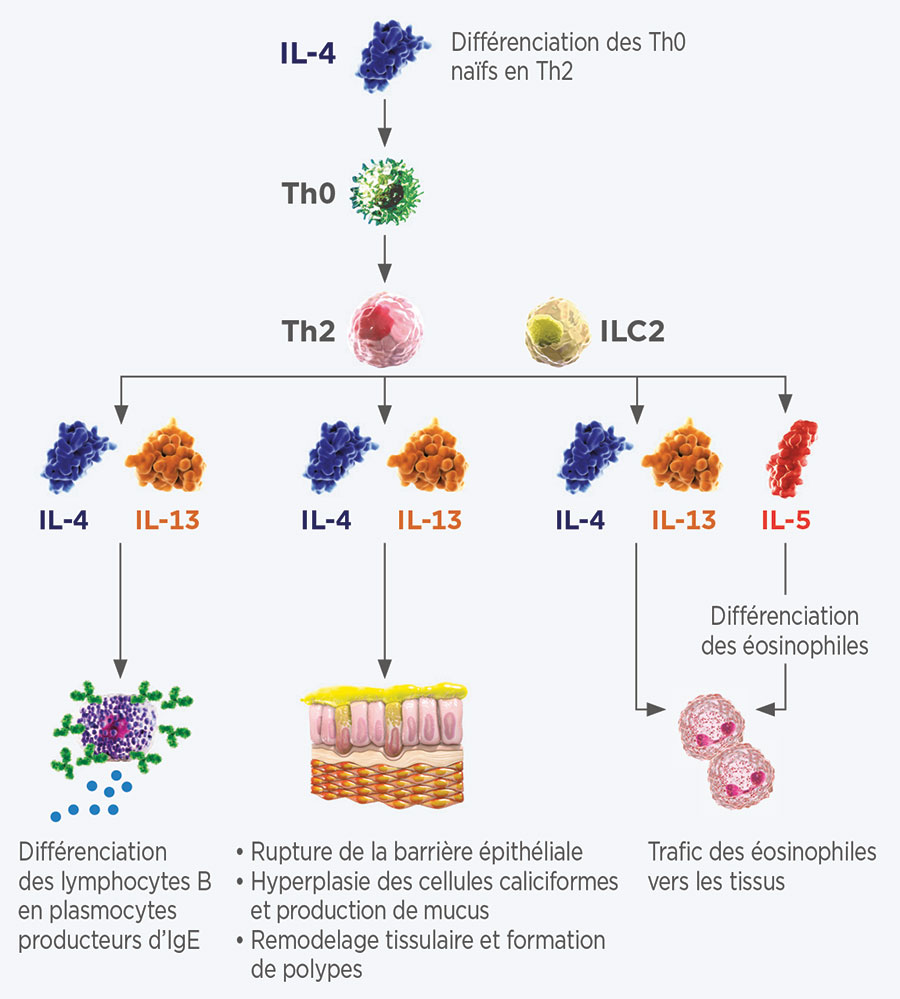
Adapté de Akdis CA, 2013 ; Schleimer RP, 2017 ; Gandhi NA, 2015 et Kato A, 2015
Ces cytokines sont à l’origine de la formation de polypes nasaux, de congestion/obstruction nasale, d’une douleur faciale, d’écoulement nasal et d’une perte d’odorat9.
IL-4, IL-13 et IL-5, cytokines majeures de l’inflammation de type 2, ont des rôles distincts, avec des chevauchements5,6.
|
IL-4 |
IL-13 |
IL-5 | |
| Différenciation des cellules Th2. |
🔵 |
|
|
| Commutation de classe des lymphocytes B et production d'IgE. |
🔵 |
🟡 |
|
| Disfonctionnement de la barrière épithéliale, hyperplasie des cellules caliciformes et hypersécrétion de mucus. |
🔵 |
🟡 |
|
| Remodelage tissulaire et formation des polypes nasaux. |
🔵 |
🟡 |
|
| Recrutement et traffic des éosinophiles vers le mucus et les tissus. |
🔵 |
🟡 |
🔴 |
| Différenciation des éosinophiles dans la moelle osseuse. |
|
|
🔴 |
IgE : immunoglobuline E ; IL : interleukine ; ILC2 : cellule lymphoïde innée de type 2 (type 2 innate lymphoid cell) ; PNS : polypose naso-sinusienne ; Th0 : lymphocyte T auxiliaire naïf ; Th2 : lymphocyte T auxiliaire de type 2 (type 2 T helper cells).
Traiter la polypose naso-sinusienne
PNS : Quelle stratégie de prise en charge3 ?
- Quelle que soit la sévérité des symptômes : Corticostéroïdes par voie nasale + lavage par solution saline à grand volume
- Symptômes sévères ou échec des corticostéroïdes locaux : corticostéroïdes systémiques en cure courte (< 10 jours) au maximum 1 à 2 fois par an ± corticostéroïdes par voie nasale
- PNS sévère et résistante à un traitement médical bien conduit, bien observé et suffisamment prolongé : chirurgie fonctionnelle endoscopique des sinus
- Récidive après chirurgie : thérapie additionnelle à envisager : chirurgie de révision ou traitements biologiques
|
Les corticostéroïdes systémiques :
|
|
La chirurgie naso-sinusienne :
|
Les récidives de polypes post-chirurgie
De nombreux patients atteints d’une inflammation de type 2 présentent une récidive endoscopique de polypes dans les 5 ans suivant la chirurgie13.
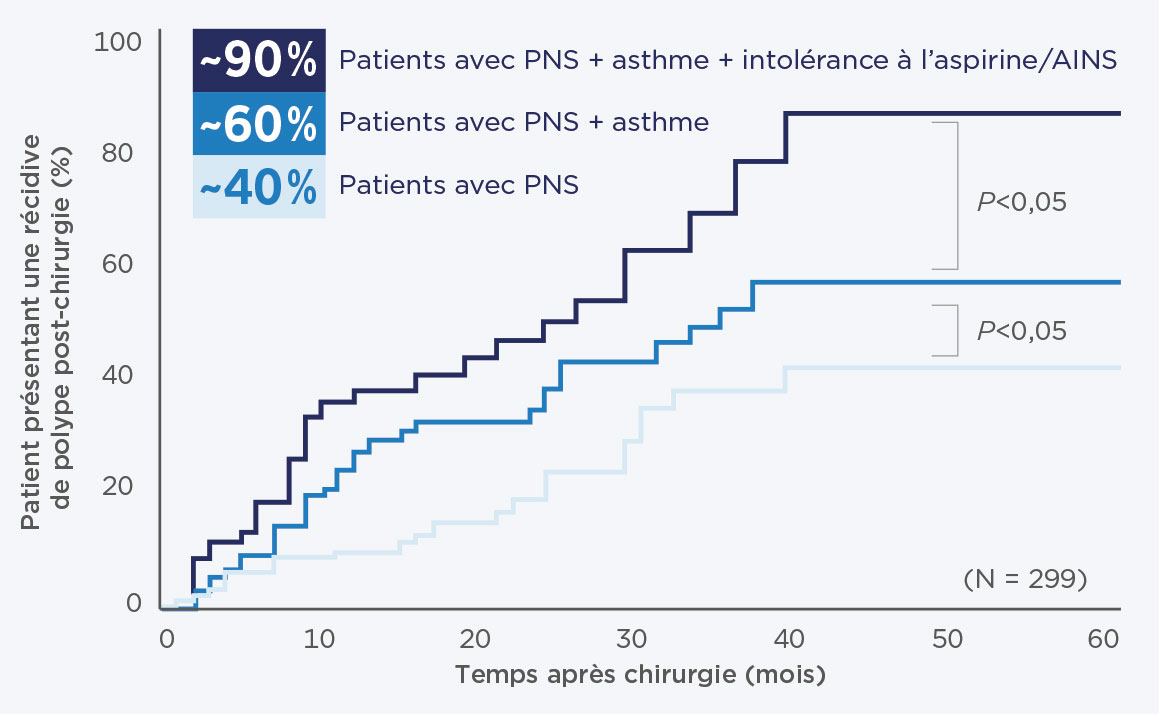
Recommandations des sociétés savantes européennes
Les sociétés savantes européennes recommandent l’utilisation de biothérapies chez les patients atteints d’une polypose naso-sinusienne sévère pour traiter l’inflammation de type 2.
EPOS et EUFOREA recommandent les biothérapies pour les patients présentant des polypes bilatéraux, ayant déjà eu recours à une chirurgie naso-sinusienne, s’ils ont au moins 3 des 5 critères suivants2,3 :
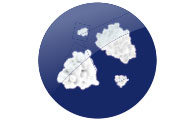
Preuve d'une inflammation de type 2*

Recours à des corticostéroïdes systémiques ou contre-indication aux corticostéroïdes systémiques.

Qualité de vie signicativement dégradée.
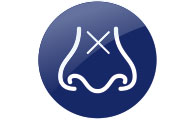
Perte significative de l'odorat.
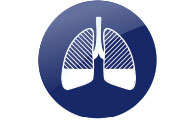
Diagnostic d'asthme comorbide.
| Avant de prescrire une biothérapie, veuillez-vous référer à l’AMM des produits et à leur place dans la stratégie thérapeutique définie par la HAS. |
*EOS tissulaires ≥ 10/hpf OU EOS sanguins ≥ 150 cellules/µL OU taux IgE ≥ 100 UI/mL.
PNS : polypose naso-sinusienne ; AINS : anti-inflammatoire non stéroïdien. AMM : autorisation de mise sur le marché ; EOS : éosinophile ; EPOS : European Position Paper on Rhinosinusitis and Nasal Polyps 2020 ; EUFOREA : European Forum for Research and Education in Allergy and Airway Diseases ; HAS : Haute Autorité de Santé ; IgE : immunoglobuline E.
Identifier l’inflammation de type 2
Dans les pays occidentaux, l’inflammation de type 2 est présente chez 80% des patients atteints de polypose naso-sinusienne1. L’inflammation de type 2 chez les patients atteints d’une polypose naso-sinusienne se caractérise par différents signes à rechercher2,3 :
- Besoin de corticostéroïdes systémiques
- Récidives post-chirurgies
- Taux d’EOS élevé et/ou taux d’IgE totales élevé
- Antécédents d’asthme et/ou autres comorbidités de type 2 (rhinite allergique, maladie respiratoire associée à une intolérance à l’aspirine/AINS, etc)
50% des patients avec une polypose naso-sinusienne ont aussi un asthme4.
Cas clinique

Charles, 59 ans, est atteint de polypose naso-sinusienne. Charles présente les symptômes suivants : perte de l'odorat, congestion/obstruction nasale, douleur faciale et fatigue.
« Ma polypose me gêne au quotidien. J’ai déjà subi une chirurgie et mon odorat n’est pas revenu… »
Dans ce cas, l’inflammation de type 2 est à considérer comme facteur de la polypose naso-sinusienne5,6.
Le profil patient est indicatif et n’est pas un patient réel.
AINS : anti-inflammatoire non stéroïdien ; EOS : éosinophile ; IgE : immunoglobuline E.
Cibler les cytokines majeures de l'inflammation de type 2
IL-4, IL-13 et IL-5 sont des acteurs clés dans la cascade inflammatoire de type 2 et participent au remodelage des tissus et à la formation des polypes5-8.

Adapté de Akdis CA, 2013 ; Schleimer RP, 2017 ; Gandhi NA, 2015 et Kato A, 2015
Ces cytokines sont à l’origine de la formation de polypes nasaux, de congestion/obstruction nasale, d’une douleur faciale, d’écoulement nasal et d’une perte d’odorat9.
IL-4, IL-13 et IL-5, cytokines majeures de l’inflammation de type 2, ont des rôles distincts, avec des chevauchements5,6.
|
IL-4 |
IL-13 |
IL-5 | |
| Différenciation des cellules Th2. |
🔵 |
|
|
| Commutation de classe des lymphocytes B et production d'IgE. |
🔵 |
🟡 |
|
| Disfonctionnement de la barrière épithéliale, hyperplasie des cellules caliciformes et hypersécrétion de mucus. |
🔵 |
🟡 |
|
| Remodelage tissulaire et formation des polypes nasaux. |
🔵 |
🟡 |
|
| Recrutement et traffic des éosinophiles vers le mucus et les tissus. |
🔵 |
🟡 |
🔴 |
| Différenciation des éosinophiles dans la moelle osseuse. |
|
|
🔴 |
IgE : immunoglobuline E ; IL : interleukine ; ILC2 : cellule lymphoïde innée de type 2 (type 2 innate lymphoid cell) ; PNS : polypose naso-sinusienne ; Th0 : lymphocyte T auxiliaire naïf ; Th2 : lymphocyte T auxiliaire de type 2 (type 2 T helper cells).
Traiter la polypose naso-sinusienne
PNS : Quelle stratégie de prise en charge3 ?
- Quelle que soit la sévérité des symptômes : Corticostéroïdes par voie nasale + lavage par solution saline à grand volume
- Symptômes sévères ou échec des corticostéroïdes locaux : corticostéroïdes systémiques en cure courte (< 10 jours) au maximum 1 à 2 fois par an ± corticostéroïdes par voie nasale
- PNS sévère et résistante à un traitement médical bien conduit, bien observé et suffisamment prolongé : chirurgie fonctionnelle endoscopique des sinus
- Récidive après chirurgie : thérapie additionnelle à envisager : chirurgie de révision ou traitements biologiques
|
Les corticostéroïdes systémiques :
|
|
La chirurgie naso-sinusienne :
|
Les récidives de polypes post-chirurgie
De nombreux patients atteints d’une inflammation de type 2 présentent une récidive endoscopique de polypes dans les 5 ans suivant la chirurgie13.

Recommandations des sociétés savantes européennes
Les sociétés savantes européennes recommandent l’utilisation de biothérapies chez les patients atteints d’une polypose naso-sinusienne sévère pour traiter l’inflammation de type 2.
EPOS et EUFOREA recommandent les biothérapies pour les patients présentant des polypes bilatéraux, ayant déjà eu recours à une chirurgie naso-sinusienne, s’ils ont au moins 3 des 5 critères suivants2,3 :

Preuve d'une inflammation de type 2*

Recours à des corticostéroïdes systémiques ou contre-indication aux corticostéroïdes systémiques.

Qualité de vie signicativement dégradée.

Perte significative de l'odorat.

Diagnostic d'asthme comorbide.
| Avant de prescrire une biothérapie, veuillez-vous référer à l’AMM des produits et à leur place dans la stratégie thérapeutique définie par la HAS. |
*EOS tissulaires ≥ 10/hpf OU EOS sanguins ≥ 150 cellules/µL OU taux IgE ≥ 100 UI/mL.
PNS : polypose naso-sinusienne ; AINS : anti-inflammatoire non stéroïdien. AMM : autorisation de mise sur le marché ; EOS : éosinophile ; EPOS : European Position Paper on Rhinosinusitis and Nasal Polyps 2020 ; EUFOREA : European Forum for Research and Education in Allergy and Airway Diseases ; HAS : Haute Autorité de Santé ; IgE : immunoglobuline E.
Références
- Chaaban MR, Walsh EM, Woodworth BA. Epidemiology and differential diagnosis of nasal polyps. Am J Rhinol Allergy. 2013;27(6):473-478.
- Fokkens WJ, Lund V, Bachert C, et al. EUFOREA consensus on biologics for CRSwNP with or without asthma. Allergy. 2019;74:2312-2319.
- Fokkens WJ, et al. European position paper on rhinosinusitis and nasal polyps. Rhinology. 2020;S29:1-464.
- Khan A, Vandeplas G, Huynh TMT, et al. The Global Allergy and Asthma European Network (GALEN) rhinosinusitis cohort: a large European cross-sectional study of chronic rhinosinusitis patients with and without nasal polyps. Rhinology. 2019;57(1):32-42.
- Gandhi NA, et al. Targeting key proximal drivers of type 2 inflammation in disease. Nat Rev Drug Discov. 2016;15(1):35-50.
- Schleimer RP. Immunopathogenesis of chronic rhinosinusitis and nasal polyposis. Annu Rev Pathol. 2017;12:331-357.
- Akdis CA, Bachert C, Cingi C, et al. Endotypes and phenotypes of chronic rhinosinusitis: a PRACTALL document of the European Academy of Allergy and Clinical Immunology and the American Academy of Allergy, Asthma & Immunology. J Allergy Clin Immunol. 2013;131(6):1479-1490.
- Kato A. Immunopathology of chronic rhinosinusitis. Allergol Int. 2015;64(2):121-130.
- Abdalla S, Alreefy H et Hopkins C. Prevalence of sinonasal outcome test (SNOT-22) symptoms in patients undergoing surgery for chronic rhinosinusitis in the England and Wales National prospective audit. Clinical Otolaryngology. 2012;34:276-282.
- Bradford Rice J, et al. Long-term Systemic Corticosteroid Exposure : A Systematic Literature Review. Clin Ther. 2017;39(11):2216-2229.
- DeConde AS, et al. Comparative effectiveness of medical and surgical therapy on olfaction in chronic rhinosinusitis: a prospective, multi-institutional study. Int Forum Allergy Rhinol. 2014;4(9):725-733.
- Krings G, et al. Complications of Primary and Revision Functional Endoscopic Sinus Surgery for Chronic Rhinosinusitis. Laryngoscope. 2014;124(4):838-845
- Bassiouni A et Peter-John Wormald. Role of frontal Sinus Surgery in Nasal Polyp Recurrence. The laryngoscope. 2012;126:36-71
- Fokkens WJ, et al. EPOS/EUFOREA update on indication and evaluation of Biologics in Chronic Rhinosinusitis with Nasal Polyps 2023. Rhinology. 2023
MAT-FR-2504738-12/25